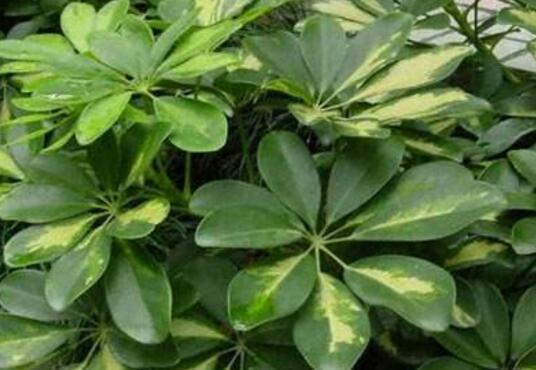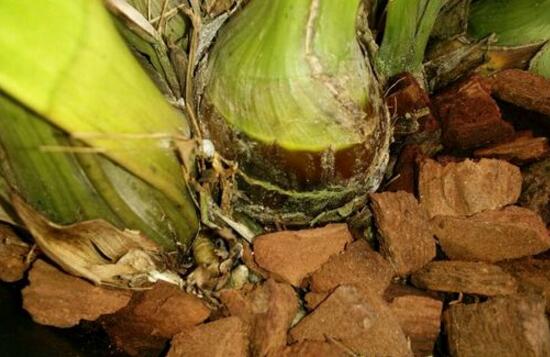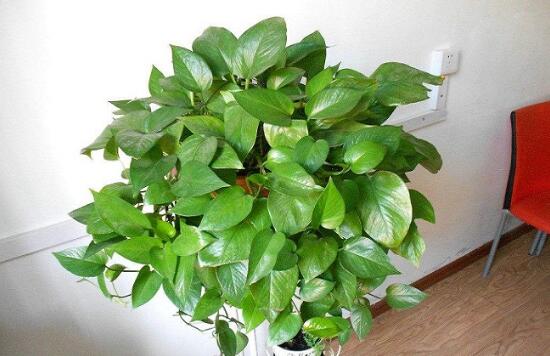What if the leaves of duck feet turn yellow and fall off? learn four tricks to prevent the leaves from falling off prematurely.
When the duck foot wood is in a suitable environment and the breeding method is correct, its leaves should be green all the year round, but some flower friends encounter the phenomenon that the leaves turn yellow and fall early when they are raised, which makes them very sad. How is it that the leaves of duck feet turn yellow and fall off? How should it be solved? Let's learn about it with the editor.
The cause of yellowing and falling off of the leaves of Duck feet
1. Too much watering

Duck foot wood is a drought-tolerant plant, except in summer, other seasons do not need frequent watering, if too much watering will lead to root rot, at the same time, root respiration will also be affected, and then the leaves will turn yellow and fall off prematurely.
2. Sun exposure
Duck foot wood can adapt to many light conditions. It can grow in full sunlight in spring and winter, but it cannot be put in the sun in summer, because the sun exposure can make the leaves turn yellow and look as if they were charred.
3. Soil consolidation
If the soil is hardened, it will prevent air, water, fertilizer and so on from entering the soil, and there is not enough space for root growth, resulting in stunted root growth and premature leaf fall.
4. Diseases and insect pests infection
Germs or eggs can be transmitted through a variety of ways, such as aphids will spread with the wind, it will also carry germs to cause the plant to be infected with leaf blight and so on, so diseases and insect pests are one of the main reasons for the yellowing and shedding of the leaves of duck feet.
What if the leaves of duck feet turn yellow?
1. Watering should be moderate. Check the wetness of the soil before each watering. If it is slightly moist, you can choose not to water it. The principle is that it would rather be dry than wet, and water again only when the soil cannot be pinched into a ball. The method can refer to the detailed description of how to water duck foot wood.
2. Shade is needed in summer. In spring, autumn and winter, duck foot wood can grow in half-day light, but it can not be exposed to the sun in summer, it should be shaded properly.
3. Change the basin soil regularly. Even if the selected soil quality is very good, the basin soil should be changed every 1-2 years, otherwise there will be hardening and so on. The best way is to change the soil and flowerpots.
4. Prevention of diseases and insect pests. Diseases and insect pests mainly lie in prevention, and the way to prevent them is to keep the environment ventilated, moderate temperature, adequate light and so on. As long as the environment is suitable, then there is no place for bacteria and eggs to survive.
What are the effects and effects of duck foot leaves?
Content Abstract: duck foot wood, alias goose palm wood, duck palm wood, belongs to the garden tree species, with the advantages of watching leaves and flowers, secondly, the plant can also be directly used medicinally, the effect is extraordinary. The plant is recorded in Araliaceae, and it was a medicinal plant variety in ancient times, but what this article will bring to you today is the efficacy and function of duck foot leaves.
[the efficacy and function of the leaves of Duck foot]
Duck foot wood, suitable for growing in a humid, semi-overcast environment, is mostly distributed in the north and a small part of the south.
▍ morphological characteristics
Duck foot wood, is a tree species, the plant height can reach more than 2 meters, the highest can grow to 15 meters.
Duck foot leaves, mostly paper, can grow into oval, oblong and other kinds, the plant length is about 9 cm, width is 3 cm, hair is attached when young, and gradually fall off in the later stage.
Main components of ▍
Duck foot wood leaf, evergreen all the year round, and good shade, is the main element of duck foot wood forming.
Duck foot leaves are rich in chemical components, such as betulinic acid, glucopyranose, rhamnose, etc., which can be used in clinical medicine to extract pure chemical elements, which can be used in the treatment of a variety of diseases. on the other hand, the leaves of duck feet are rich in chemical components and have higher research value.
Drug basis of ▍
Duck foot wood leaves, cold, bitter taste, slightly astringent, can be taken internally as medicine.
Duck foot leaves have been recorded in "Guangxi Folk commonly used Chinese Herbal Medicine", which can be used for internal and external use.
Internal service: directly boil the duck foot wood with water, the soup can be taken internally, and it can also scrub the affected area. Can also be directly processed duck foot leaves, crushed into the end can be directly made into pills for internal use, the dosage of duck feet leaves should not exceed 15g each time.
External use: for external use, you can directly choose fresh duck foot leaves, mash them, mix them with medicinal wine, apply them to the affected area, or directly add egg whites, or you can also apply them to the injured position. The processed duck foot leaves can be dried and fried with sake directly, which has a remarkable effect on medicine.
▍ attending efficacy
1. Duck foot wood leaf, directly used in medicine, is suitable for patients with wind-fever and cold, as well as those with excessive moisture in the body. it has a strong effect of detoxification and promoting blood circulation.
two。 Duck foot wood leaf, can be used in patients with sore throat, or dry and inflamed patients, can be taken directly.
3. If there is a traumatic infection, or traumatic itching and other symptoms, can be mashed duck feet leaves, external application in the affected area.
4. There are lower limb ulcers, or skin burns, rheumatism and other diseases, can also be treated directly through the duck foot leaves, also with egg white harmony, smear the affected area.
5. Duck foot wood leaf, has a certain hemostatic effect, when there is trauma, it can stop bleeding, the effect is very strong.
Conclusion: duck foot leaves are slightly toxic and are not suitable for pregnant women. Secondly, when duck feet leaves are used externally, it is recommended to mash the juice directly and smear the affected area with cotton swabs, so as to avoid direct contact with the affected skin and wound irritation.
Hydroponic culture method of duck foot wood leaf (goose palm wood)
The method of hydroponic culture of duck foot wood
Method 1: water culture of branches
Cut 10 cm semi-lignified branches from the duck foot plant, and with more than 2-3 leafy branches, cut off the lower branches and leaves, leaving only 1-2 palmately compound leaves. Then put the branch 2stroke 3 into the water and put it in a place where there is plenty of sunshine.
When the ambient temperature is more than 15 ℃, white calli will be formed in about 10 days, and adventitious roots will be formed in a few days.
In about 45 days, the roots of 6cm can grow from the duck foot wood, which can be managed normally at this time.
Method 2: soil culture plant root washing water culture method
Remove the soil-grown duck foot wood from the soil, wash the soil from the roots, and put the plant into a glass bottle filled with water (tap water needs to be stored for 2-3 days).
In the initial stage of hydroponic culture, the water should be changed every 2-3 days, the temperature should be controlled above 15 ℃, the light should be added properly, and a few drops of nutrient solution should be added to the water when changing water.
The culture method of hydroponic duck foot wood
Change water in time
Hydroponic duck feet need to change the water once a week, each time to add a few drops of nutrient solution to the water, can make the roots of duck feet more robust. The water level leaves in the hydroponic container should not be too high and should not spread over the trunk position.
Control temperature
The suitable temperature for the growth of duck foot wood is 15-25 ℃, and it can grow normally when it is over 30 ℃. The winter temperature should not be lower than 5 ℃, otherwise the leaves will fall off.
Plenty of light.
The growth of duck foot wood needs enough light, and plenty of sunlight can make it bright at night. But the duck foot wood leaf is shady, can also keep the leaf color thick green in the semi-shade place. However, hydroponic duck feet should bask in the sun regularly, but moderate sunshade is needed in summer.
- Prev

What about the rotten roots of Cymbidium, the treatment of the rotten roots of Cymbidium / change the pot in time
Cymbidium, a hybrid variety of orchids, has large flowers and rich colors, so it is deeply loved by flower friends. In life, many people raise Cymbidium, but in the process of breeding, they often encounter the phenomenon of rotten roots. What about the rotten roots of Cymbidium? Next
- Next

Does green orchid absorb formaldehyde? the efficacy and function of green orchid / formaldehyde absorption can also cure diseases.
I do not know since when, to raise a pot of plants indoors has become more and more popular, especially in the newly decorated house, put several pots of green orchid inside, it is said to have the role of absorbing formaldehyde, does that green orchid absorb formaldehyde? In this regard, we can understand through the efficacy and function of green orchid, it is not only good-looking
Related
- Fuxing push coffee new agricultural production and marketing class: lack of small-scale processing plants
- Jujube rice field leisure farm deep ploughing Yilan for five years to create a space for organic food and play
- Nongyu Farm-A trial of organic papaya for brave women with advanced technology
- Four points for attention in the prevention and control of diseases and insect pests of edible fungi
- How to add nutrient solution to Edible Fungi
- Is there any good way to control edible fungus mites?
- Open Inoculation Technology of Edible Fungi
- Is there any clever way to use fertilizer for edible fungus in winter?
- What agents are used to kill the pathogens of edible fungi in the mushroom shed?
- Rapid drying of Edible Fungi

